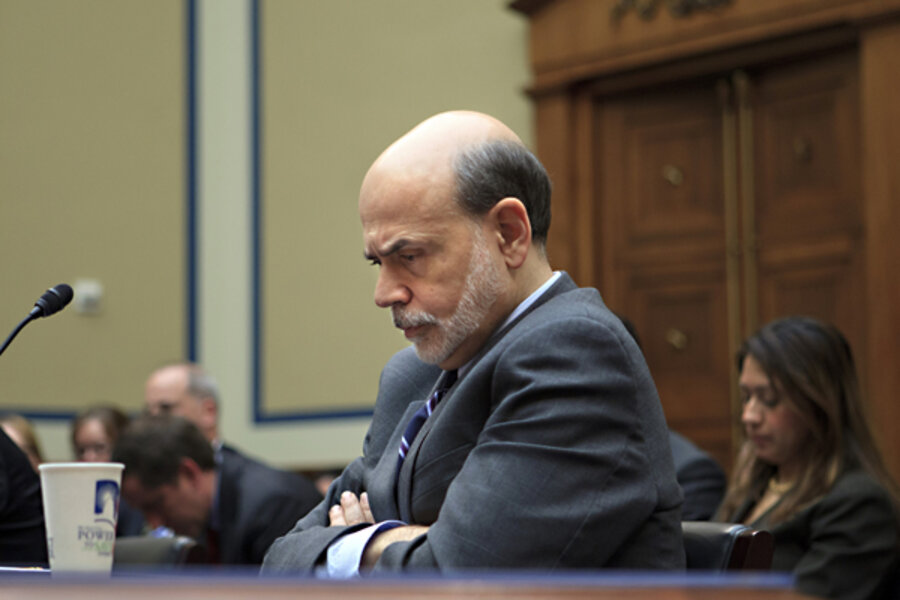What Bernanke gets wrong about the gold standard
Loading...
Federal Reserve Chairman Ben Bernanke went back to the classroom to educate young minds at George Washington University about the history and role of central banks and the Federal Reserve in particular.
On the topic of financial panics, Bernanke asks the students if they’ve seen the movie “A Wonderful Life.” Not as many students had seen the movie as he had hoped. Bank panics are a serious problem Bernanke explains. Banks borrow short and make long-term loans that are illiquid.
This would have been a perfect time to talk about unviability of fractional-reserve banking. However, Professor Ben avoided that and instead waxed eloquent about a perfect world where Jimmy Stewart would be able to borrow from a lender of last resort–the central bank– and FDIC deposit insurance would quell unsettled depositors.
Bernanke cites Walter Bagehot’s axiom that central banks must lend freely in a panic, against good collateral, at penalty interest rates. After all, the central bank doesn’t want borrowers taking advantage of cheap rates to get through the crisis.
No student hands shot up to question the Fed Chair as to how a Fed Funds rate of zero to 25 basis points could be defined as a “penalty rate.”
“Gold standards are far from perfect,” Bernanke said. “ They waste of resources,.” citing Milton Friedman’s quip about taking gold from one hole in the ground just to transfer it to other hole.
Gold standards are far from perfect because government bureaucrats have always been in charge of managing them. The mere fact that heavy costs and resources are involved to mine the yellow metal is one of the factors making gold a perfect money.
A gold-shackled currency takes away central bank flexibility, which bothers Bernanke. But the question is, how much Bernanke flexibility can the dollar stand before it falls apart completely?
The Fed Chair admitted that the gold standard provides price stability–but only in the long run. He stressed that there have been short-term periods of price inflation and deflation under gold. Well sure, prices increase and then correct, that’s what a gold standard does. Under central bank management prices just increase; either slowly, quickly, or catastrophically.
Exchange rates are fixed under gold thus, Bernanke told the students, shocks in the money supply in one country will affect other countries. He used the example that an accommodative monetary policy by his employer would cause inflationary pressures in China, because the yuan is tied to the dollar.
Bernanke cited speculative attacks on gold-backed currencies as a problem, saying that if it’s believed there isn’t enough gold backing the currency there can be a run on that currency. This is a human problem, not a gold problem. The same thing occurs more often under fiat currency systems. This is the way the market should work.
Amazingly, the Fed Chair rolled out the tired old “there isn’t enough gold to maintain a gold standard” argument. Showing a slide of William Jennings Bryant, Bernanke told of farmers struggling with debt that was fixed, while the price of their crops was dropping. Bryan called for a monetization of silver to increase crop prices.
Nigam Arora picks up on this theme in a piece for “The Trading Deck” on MarketWatch. Mr. Arora writes that Bernanke did a great job and thinks his “comments today on the gold standard may help those who are genuinely trying to make money from their investments.”
Arora writes that there just isn’t enough gold for the modern economy and the production of gold can’t keep up. He cites the Conference Board’s prediction that the world economy will grow by 3.6% this year, and gold production only grows 2-4% a year.
“The point is that the production of gold does not increase enough to accommodate growth in world economy,” Arora writes. “Then there is a peak gold theory which states that gold production has either peaked or will peak sometime in the near future. In contrast, the world economy will continue to grow.“
But growing the money supply doesn’t grow an economy: only real savings does. “Neither the Fed nor the government can grow the economy,” explains Frank Shostak. “All that stimulatory policies can do is to redistribute real savings from wealth producers to nonproductive activities. And these policies encourage consumption that is not supported by useful production.”
The redistribution created by the Fed’s monetary pumping actually weakens the economy over time as real savings is squandered on malinvestments. With gold as money, real production and savings is stimulated. Capital and savings flow to the most efficient and best producers.
Mr. Arora writes that South Africa is number one in gold mining followed by the US. Actually both of these countries are behind China and Australia, with Russia on the verge of pushing South Africa into the number five spot.
His bigger point is that countries without significant gold production would not be interested in a gold standard. No political class anywhere is interested in the gold standard because it limits government expenditures.
Arora’s hedge fund is short gold and owns inflation hedges “that have lower risk and higher rewards compared to gold.” He writes, “playing gold as a speculation based on momentum and confusing it with the gold standard and monetary policy without deep understanding of these subjects is a losing proposition.”
Arora’s arguments give us an idea how deep his understanding is: about the same as Chairman Bernanke’s.







